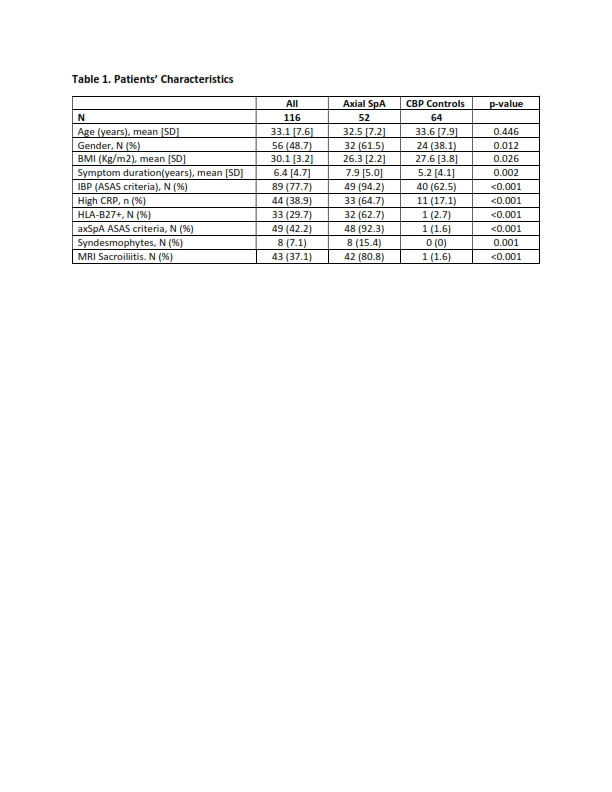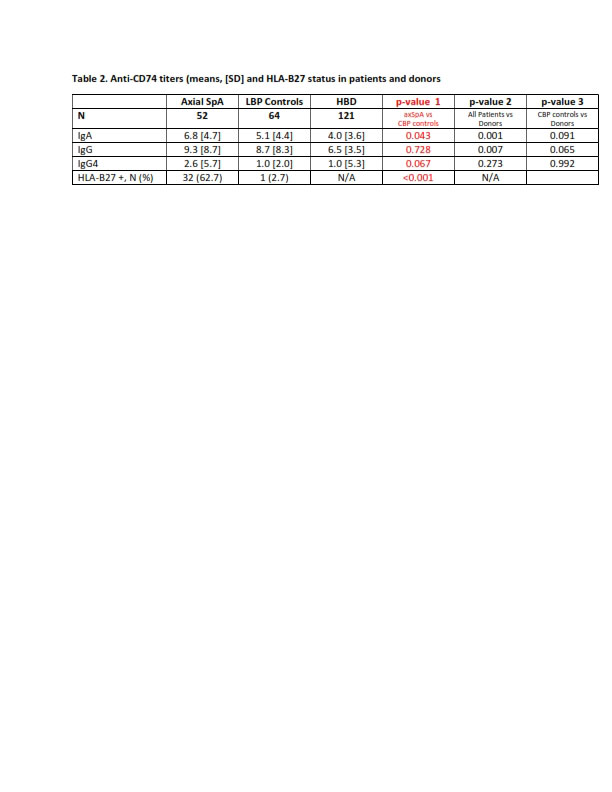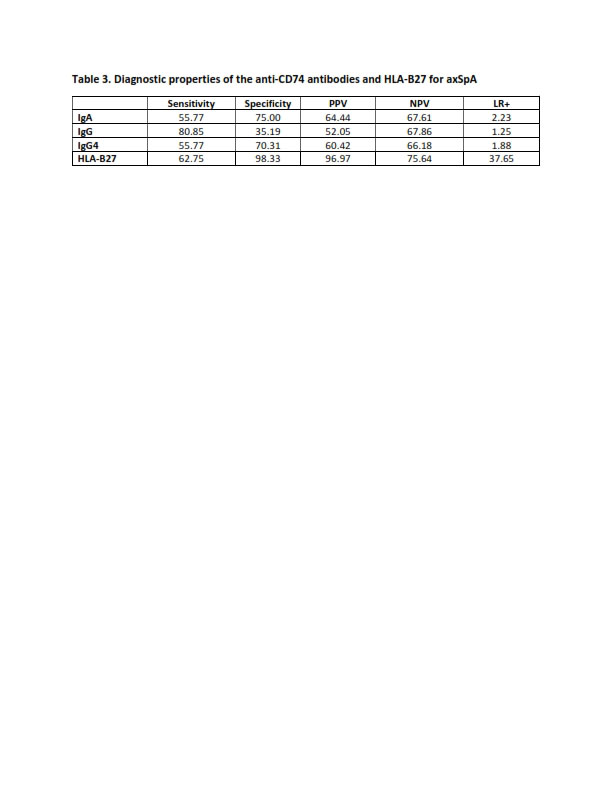Session Information
Date: Sunday, November 13, 2022
Title: Spondyloarthritis Including PsA – Diagnosis, Manifestations, and Outcomes Poster III
Session Type: Poster Session C
Session Time: 1:00PM-3:00PM
Background/Purpose: Patients with axial spondyloarthritis (axSpA) are diagnosed late, partially due to the absence of a reliable biomarker. The diagnostic value of the anti-CD74 antibodies is controverted and the heterogeneity in previous study results may be due to the differences in study populations. In this prospective study, we tested the diagnostic properties of IgA, IgG, and IgG4 anti-CD74 antibodies for axSpA in patients referred for suspicious chronic low back pain (LBP) in Iraq and Lebanon, where the HLA-B27 prevalence is known to be relatively low.
Methods: This is a prospective, multicentric study including adult patients aged less than 45 years and presenting with a history of more than 3 months of “suspicious” LBP which needed a referral to the rheumatologist. Sera of LBP patients and healthy blood donors (HBD) were analyzed for IgA, IgG, and IgG4 by ELISA. Comparison between groups was performed with the Mann-Whitney U test. For the diagnostic properties of anti-CD74 antibodies, ROC curves were calculated to identify the local threshold of positivity. The diagnostic properties of the anti-CD74 antibodies were calculated (sensitivity, specificity, positive predictive value, negative predictive value, and positive likelihood ratio (LR+)).
Results: The sera of 116 patients (52 axSpa and 64 LBP controls) and 121 HBD were analyzed. Patients’ characteristics are reported in Table 1: more males, inflammatory back pain, HLA-B27 (62.7% versus 1%), high CRP, MRI sacroiliitis, and syndesmophytes were found in axSpA patients compared to LBP controls. IgA titers were significantly higher in axSpA patients compared to LBP controls (p=0.043); IgG and IgG4 titers were only numerically higher (Table 2). There was no statistically significant difference in titers between LBP controls and HBD. In the ROC analysis, IgG4 and IgA anti-CD74 showed the best diagnostic properties for axSpA (AUC 0.643 and 642, respectively). Using the ROC curve-identified cut-off value, positive values of IgA were found in 56% of axSpA and 25% of LBP (p< 0.001), of IgG in 81% of axSpA and 64% of LBP (p=0.073) and of IgG4 in 56% of axSpA and 30% of LBP (p=0.005). The LR+ was highest for IgA (2.23) followed by IgG4 (1.88) and IgG (1.25). As a comparator, the LR+ of HLA-B27 was 37.65 (Table 3).
Conclusion: In patients referred for a suspicious chronic LBP to the rheumatologists, IgA anti-CD74 were significantly associated with the final diagnosis of axSpA. However, the LR+ was modest, particularly in comparison with HLA-B27, which may be probably related to the nature of the comparator arm of suspicious LBP.
To cite this abstract in AMA style:
Ziade N, Maroof A, Abi Najm A, Witte T, Baraliakos X. Value of the Anti-CD74 Antibodies for the Diagnosis of Axial Spondyloarthritis: Results of a Prospective Study in Patients with Suspicious Low Back Pain [abstract]. Arthritis Rheumatol. 2022; 74 (suppl 9). https://acrabstracts.org/abstract/value-of-the-anti-cd74-antibodies-for-the-diagnosis-of-axial-spondyloarthritis-results-of-a-prospective-study-in-patients-with-suspicious-low-back-pain/. Accessed .« Back to ACR Convergence 2022
ACR Meeting Abstracts - https://acrabstracts.org/abstract/value-of-the-anti-cd74-antibodies-for-the-diagnosis-of-axial-spondyloarthritis-results-of-a-prospective-study-in-patients-with-suspicious-low-back-pain/



